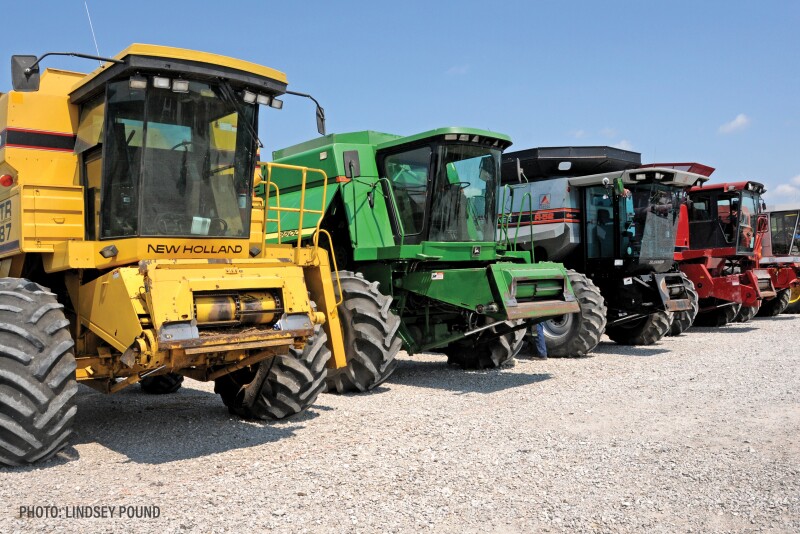Soybean producers: Extend 2025-crop sales...November soybeans have rallied to a 4 1/2 month high, hitting our target of $10.70. We advise soybean hedgers and cash-only marketers to sell another 10% of the 2025-crop to get to 30% sold in the cash market. Be prepared to make additional sales on extended price strength. Check our advice monitor on ProFarmer.com
There’s been no let-up when it comes to signs of stress for the farm machinery market, which continues to face waning demand and deteriorating credit quality, wrote Gerald Mashange, assistant professor of agricultural and consumer economics at the University of Illinois in a farmdoc paper.
“Multiple indicators—from manufacturer production cuts to rising loan write-offs—point to a challenging environment confronting dealers, manufacturers, and producers alike,” he wrote.
Mashange highlighted Creighton University’s Rural Mainstreet Index, which surveys bank CEOs across a ten-state region and provides monthly assessments of farm equipment sales conditions along with other measures.
The farm equipment sales index has remained below 50 for most of 2024 and throughout 2025. A reading below 50 indicates contraction. October 2025 saw the index post one of its lowest readings since 2020, indicating a substantial contraction in equipment sales activity across a 10-state region, the economist noted.
Meanwhile, total inventories in the farm machinery and equipment manufacturing sector have declined sharply after peaking at around $7.23 billion in October 2022, Mashange observed. By July 2025, inventories had dropped to around $5.65 billion, a decline of 21.9% but still well above pre-2020 levels.
The decline reflects efforts by manufacturers to realign dealer inventories in response to weak demand, he said, with John Deere and CNH Industrial scaling back production and announcing multiple job cuts.
Mashange noted price increases have also moderated amid slowing demand after a post-Covid spike that peaked at 19% year–over-year in February 2022. By April 2024, the PPI year-over-year change had slowed to low single digits, reaching just 1.34% in August 2025, though machinery prices remain well above pre-2021 levels.
It’s a similar story when it comes to credit-market indicators, Mashange said, observing that loan volumes for farm machinery and equipment at commercial banks have continued to trend lower, according to data from the Survey of Terms of Lending to Farmers and the Federal Reserve Bank of Kansas City. Loan performance data from manufacturers has also suffered as credit quality has deteriorated, he said.
“Combined with reduced loan volumes and rising write-offs, these indicators suggest the farm machinery and equipment market downturn may persist as farmers navigate political uncertainty, weak commodity prices, elevated input costs, and tight credit conditions,” Mashange wrote. “Manufacturers and dealers will likely continue adjusting production and inventory levels to align with subdued demand, while lenders face increasing pressure from deteriorating loan performance in their agricultural machinery and equipment portfolios.”
Trade talks bring cheer….it isn’t just China
A framework agreement that Treasury Secretary Scott Bessent said would see China make “substantial” purchases of U.S. soybeans stole the spotlight Monday, sending soybean futures soaring and providing a lift for corn and wheat. But a handful of trade-related agreements with Southeast Asian countries were also winning praise from commodity groups.
President Donald Trump, who is attending a summit of the Association of Southeast Asian Nations in Kuala Lumpur, signed reciprocal trade deals with his Malaysian and Cambodian counterparts, along with a framework trade agreement with Thailand, Reuters reported. A similar framework agreement with Vietnam was also signed.
“This is all very good news for the nation’s corn growers. Eliminating tariffs on ethanol exports to Malaysia and Cambodia will boost demand,” said Jed Bower, president of the National Corn Growers Association, in a statement. “We are encouraged to see that the framework for Thailand included agriculture purchases of corn and DDGS (distiller dried grain solubles). The announced framework for Vietnam is also promising, as this is already a robust market for DDGS and corn growers are well positioned to supply corn and ethanol as well.”
The American Soybean Association heralded elements of the agreements, including a commitment from Thailand to purchase U.S. soybean meal.
“We appreciate President Trump’s recognition of the promise markets in Southeast Asia hold for U.S. soybean exports, and we applaud the work of the administration to increase market access in that region,” said ASA President Caleb Ragland, in a statement. “We look forward to future deals like these that reduce tariffs and ensure continued and increased market access for U.S. agriculture and urge all parties to swiftly bring these frameworks and agreements to fruition,” he said.
See: Historic Trade Deals with Southeast Asia Open New Markets for U.S. Pork, Beef
Notable closes…
January soybeans rose 23 cents to $10.83 ¼, hitting a 12-month high, boosted by hopes a trade framework agreed by U.S. and Chinese negotiators over the weekend will see Beijing begin buying U.S. soybeans. Wheat was also lifted, with December SRW rallying 13 ½ cents to $5.26, hitting a six-week high.

